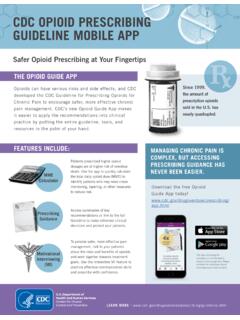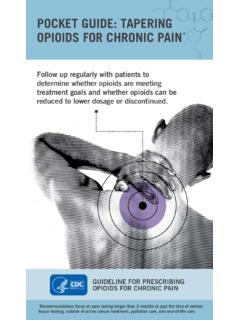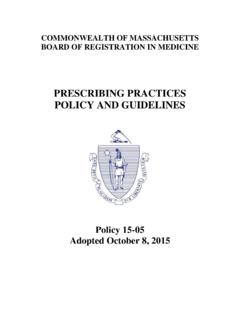Transcription of Opioid Policy - nashp.org
1 Opioid Policy Opioid misuse, overdose, and deaths are preventable, yet in the United States more than 130 people die each day from Opioid related drug overdoses. The Opioid epidemic has social and financial implications for states, including spending on health care, social services, education, and criminal justice. Evidence-based ways to prevent Opioid overdose deaths include reducing Opioid prescribing , reducing exposure to opioids, preventing misuse, and treating Opioid use disorder. CDC data has shown a trend in increased overdoses related to illicit opioids over the last several years, which has implications on the criminal justice and social service system, as well as the health care system. Existing resources and Policy tools that address What agencies in state government can address opioids opioids - Trauma-informed approaches - Offices of substance use services - Licensing agencies - State prescription drug monitoring programs - Departments of behavioral health - Justice departments - Health providers licensure authority - Medicaid agencies - Social services agencies - Public safety infrastructure - Public health agencies - Veterans' offices - Governors' offices State Policy Options Prevention of Opioid use disorder.
2 States can use prescription drug monitoring programs, regulation of controlled substances, licensing of health care providers, drug formulary management, and other strategies to prevent Opioid overdoses and harm. o Prescription drug monitoring programs. States can pass legislation and promulgate regulations that require prescribers to consult prescription drug monitoring programs when prescribing opioids or other scheduled drugs. o prescribing guidelines. States promote use of CDC's 2016 Guideline for prescribing Opioids for Chronic Pain, stay up-to-date with CDC's Opioid Workgroup recommendations, and implement their own guidelines through prescribing regulations or within Medicaid programs. o Licensing. States can use licensing and continuing medical education requirements as levers to ensure providers are trained in safe Opioid prescribing practices. Trauma-informed and family-centered treatment.
3 There is a strong link between trauma and Opioid use disorder, so a trauma-informed approach to care for both children and parents and an integrated care plan for a family unit can help mitigate the cycle of substance use disorder. Focus on social and economic factors leading to Opioid use. Comprehensive approaches to the Opioid crisis require addressing the underlying social and economic factors that contribute to the crisis, such as pain complaints, emotional distress, suicidal feelings, substance abuse, and drug overdoses. Access to treatment and life-saving drugs. States can expand access to evidence-based treatments, including medication-assisted therapy (MAT). States also can expand access to harm reduction programs including syringe services programs and Naloxone by making it readily accessible through standing orders, at pharmacies, and to law enforcement, emergency medical staff, and community-based organizations.
4 With the increase in illicit Opioid use, states can explore Incarceration-based treatment opportunities. Aligning resources and policies across agencies. States can encourage greater communication and collaboration between public health, behavioral health, social services, Medicaid, and law enforcement to improve data sharing, surveillance, and targeting of interventions. 1. Evidence and Resources for State Leaders Policy Resource Notes Prevention and US Department of Health and 1. Access: Better prevention, treatment, and recovery services treatment of Opioid Human Services' 5-Point Strategy To 2. Data: Better data on the epidemic use disorder Combat the Opioid Crisis 3. Pain: Better pain management 4. Overdoses: Better targeting of overdose-reversing drugs 5. Research: Better research on pain and addiction Substance Abuse and Mental Health STR funding was the first round of federal funding under the CURES Act Services Administration's (SAMHSA) designed to address the crisis by increasing funds to support prevention, State Targeted Response (STR) treatment, and recovery.
5 SOR is the second round of federal funding for State Opioid Response (SOR) states. Strategies include innovative models of medication-assisted treatment Grants delivery, enhanced community prevention, messaging strategies, and peer support recovery strategies. SUPPORT for Patients and The Substance Use-Disorder Prevention that Promotes Opioid Recovery and Communities Act Treatment (SUPPORT) for Patients and Communities Act is designed to advance treatment and recovery initiatives, improve prevention, protect communities, and bolster efforts to fight deadly illicit synthetic drugs. Centers for Disease Control and Recommendations for primary care clinicians who are prescribing opioids Prevention's (CDC) Guideline for for chronic pain outside of active cancer treatment, palliative care, and end- prescribing Opioids for Chronic Pain of-life care. Trauma-informed and NASHP's State Strategies to Meet Parental Opioid use is considered an adverse childhood experience (ACE).
6 Family-centered the Needs of Young Children ACEs are associated with chronic health conditions, risky behaviors, lower treatment and Families Affected by the Opioid academic achievement, and early death. Crisis Centers for Medicare & Medicaid's This new model addresses fragmentation in the care of pregnant and (CMS) Maternal Opioid Misuse postpartum Medicaid beneficiaries with Opioid use disorder through state- (MOM) Model driven transformation of the delivery system surrounding this vulnerable population. The model supports the coordination of clinical care and integration of other critical health services for health and recovery and has the potential to improve quality of care and reduce costs for mothers and infants by providing $51 million to 10 states (CO, IN, LA ,ME, MD, MO, NH, TN, TX, WV) over the next 5 years. CMS Integrated Care for Kids (InCK) The Integrated Care for Kids (InCK) Model is a child-centered local service Model delivery and state payment model that aims to reduce expenditures and improve the quality of care for children under age 21 covered by Medicaid through prevention, early identification, and treatment of behavioral and physical health needs, including impacting Opioid addiction through care integration across the state.
7 $126 million has been awarded to CT, IL, NC, NJ, NY, OH, and OR for the 7-year model, launched in 2020. Focusing on social National Institute of Health's Full The higher rates of pain complaints, emotional distress, suicide, substance and economic factors Summary - Contributions of Social abuse, and drug overdoses in the United States compared to other that lead to Opioid and Behavioral Research in developed countries suggest that evidence-based changes in current US. use Addressing the Opioid Crisis social and economic policies could impact these health issues. Access to treatment SAMHSA's resources on medication- States can expand access to evidence-based medical treatments. and life-saving drugs assisted therapy (MAT). Surgeon General's Advisory on Naloxone is a safe antidote to a suspected overdose. Keeping it within reach Naloxone and Opioid Overdose and knowing how to use it when given in time, can save a life.
8 CDC's Syringe Services Programs As described in the CDC and US Department of Health and Human Services guidance, syringe services programs are an effective component of a TFAH, Promoting Health and Cost comprehensive, integrated approach to HIV prevention for people who Control in States, p. 22-26: Syringe inject drugs. Research demonstrates that comprehensive programs are safe, Access Programs effective, and cost saving. Aligning resources Pennsylvania's Opioid Operations Pennsylvania's Opioid Command Center and Unified Coordination Group and policies across Command Center represents 14 state agencies. agencies 2.





